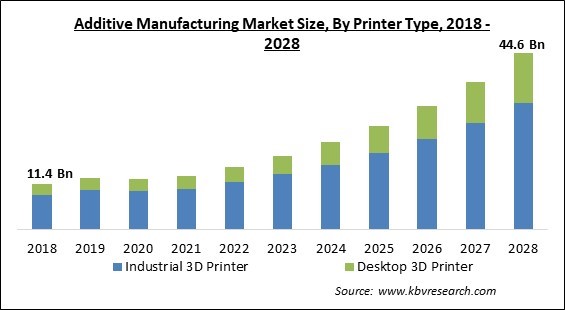The Global Additive Manufacturing Market size is expected to reach $44.6 billion by 2028, rising at a market growth of 18.9% CAGR during the forecast period.
Additive manufacturing, also called 3D printing, is the process of creating a three-dimensional object from a computerized 3D or CAD model. As the name implies, additive manufacturing involves the layer-by-layer addition of materials to create an item. Metal powders, polymers, and ceramics are examples of these materials. By machining, cutting, casting, molding, processing, and other subtractive fabricating techniques, additive manufacturing can supplement and sometimes replace traditional methods for creating products. The object is designed using CAD (Computer-Aided Design) programming or by scanning the item to be manufactured in additive manufacturing. The product can convert the scan into a precise structure that the 3D printing machine can follow layer by layer.
In order to take advantage of AM's inherent advantages, it's vital to quantify the basic characteristics in comparison to traditional approaches. The need for design tools geared especially to relevant technical as well as economic aspects of additive manufacturing is identified as a result of this understanding. Another important feature of additive manufacturing is its potential to manufacture pieces that would not be feasible with standard production methods. A lattice structure, for example, can assist manufacturers in designing an object that is lighter and consumes less material than a solid. Traditional means of production, such as casting and milling, are not well-suited to creating those delicate lattices. Parts may not cleanly exit molds. When the material is removed from various directions, milling costs increase. This cost can be saved by leveraging the additive manufacturing approach.
The execution of additive manufacturing is comprised of several processes, such as delivering deployment services, providing consultation solutions as well as customer support, and managing numerous factors related to licensing, copyrights, and patenting. In addition, it can also aid manufacturers in designing the final product and structure, prototyping, modeling, and reducing the time to the market. Resultant, the expenses that are occurred in the production process have been significantly reduced which has strengthened the position of delivering more precision in the final good at affordable prices. Hence, the adoption of these devices is estimated to surge owing to their benefits.
Moreover, additive manufacturing also has various distinct benefits. In the traditional manufacturing technique, there is a requirement of significant investment along with a lot of time that can only be recovered by very high-volume production. However, with the advent of the additive manufacturing technique, several phases of the supply chain are majorly accelerated. The speed at which a single part can be obtained becomes much faster as the consumer can send a design directly through their computer systems to a 3D printer.

The COVID-19 epidemic has had a significant impact on the world economy and, as a result, the additive manufacturing business also suffered a downfall. Lockdowns and limitations on the movement of people and products enforced by many governments throughout the world to stop the spread of the coronavirus often disrupted the logistics and the supply chain, caused a labor shortage, and hampered the manufacture of additive manufacturing printers. These restrictions and lockdowns slowed the market's expansion significantly.
When compared to other traditional manufacturing processes, the fundamental physical difference in how items are manufactured with the additive manufacturing process generates several key functional distinctions. The capacity of additive manufacturing to build complicated geometries that would be challenging to achieve using traditional manufacturing processes is the most significant of these functional changes. These complex geometries are also more durable and lighter than standard geometries. Custom hearing aids, dental mouth guards, prostheses, and orthotics, for example, can all benefit patients' quality of life and medical performance.
When manufacturing organizations use additive manufacturing processes to create items, they receive a variety of benefits. Additive manufacturing is appropriate for low-cost manufacturing as well as small and large series since the sophistication of the element has little or no effect on the manufacturing costs and time. Changes to the design can be made rapidly and at a very reasonable cost. In contrast to subtractive methods, like chemical etching and metal structures, are built atom by atom in additive manufacturing. As a result, practically every piece of metal is used during the manufacturing process, resulting in little material waste and reduced waste. All of the supplementary elements that are required for assembly, like brazing, fasteners, or welding, can be removed when using additive manufacturing.
Although additive manufacturing could significantly improve production speed and volume, it would still be impossible to produce large individual items. This is yet another significant challenge that additive manufacturing experts face as they seek new applications for the technology. Because existing additive manufacturing technologies have a restricted construction envelope, even larger items that can be printed must still be connected using mechanical joining or welding. Academia, government, and commerce are all facing significant challenges in leveraging the capabilities due to this barrier.

Based on Printer Type, the market is segmented into Industrial 3D Printer and Desktop 3D Printer. In 2021, the desktop 3D printed segment recorded a significant revenue share of the additive manufacturing market. Hobbyists and small businesses were the first to use desktop 3D printers. Desktop 3D printers, on the other hand, are rapidly being used for home and household uses. Desktop 3D printers are also being empolyed in educational institutes, schools, and universities for technical instruction and research. Small companies are more likely to use desktop 3D printers and broaden their operations to include additive manufacturing as well as other related services. As a result, demand for desktop printers is predicted to increase during the forecast period.
Based on Technology, the market is segmented into Stereolithography, Fuse Deposition Modeling, Selective Laser Sintering & Direct Metal Laser Sintering, Polyjet Printing & Inkjet Printing, Electron Beam Melting & Laser Metal Deposition, Digital Light Processing, and Laminated Object Manufacturing & Others. In 2021, the Stereolithography segment witnessed the largest revenue share of the additive manufacturing market. Stereolithography is one of the most traditional and widely used printing techniques. Apart from its ease of use, stereolithography has a number of other advantages that are driving its adoption. In addition, the technique for manufacturing is majorly being utilized in several small and medium enterprises due to its affordability. This factor is playing a major role in driving the growth of this segment.
Based on Component, the market is segmented into Hardware, Software (Design, Printer, and Scanning & Inspection), and Services. In 2021, the services segment registered a substantial revenue share of the additive manufacturing market. The expanding application portfolio of additive manufacturing across numerous industries and industry verticals, as well as the increased use of quick manufacturing methods such as rapid prototyping, are likely to drive demand for additive manufacturing services.
Based on Application, the market is segmented into Prototyping and Tooling & Functional Parts. In 2021, the prototyping segment registered the highest revenue share of the additive manufacturing market. The prototype technique is widely employed across a variety of businesses and verticals. Prototyping is used extensively in the automotive and aerospace and military industries to precisely design and build components, parts, and complex systems. Manufacturers can experience improved accuracy and manufacture more reliable end-products by prototyping. As a result, the growth of this segment is estimated to surge in the forecast period.
Based on Material, the market is segmented into Metal, and Polymer & Ceramic. In 2021, the polymer & ceramic segment held a significant revenue share of the additive manufacturing market. Although ceramic additive manufacturing is a relatively new technique, market players are conducting R&D initiatives for AM technologies like inkjet printing and FDM, which are boosting the demand for ceramic AM. Using the AM approach, businesses can build complex, delicate parts more quickly and with greater precision and accuracy. Furthermore, improved material utilization allows manufacturers to considerably lower their production costs. Hence, the growth of this segment is being augmented due to this.
Based on Vertical, the market is segmented into Automotive, Consumer Electronics, Aerospace & Defense, Educational Purpose, Healthcare & Dental, Fashion & Jewelry, Power & Energy, Food, and Others. In 2021, the automotive segment acquired the highest revenue share of the additive manufacturing market. The rising growth of the segment is attributed to the increasing adoption of additive manufacturing in the automotive industry. Additive manufacturing in the automotive industry allows the fabrication of components without the use of tools, lowering production and development costs. Parts produced by the repeatable additive process can be fitted immediately in serial manufacturing vehicles.
| Report Attribute | Details |
|---|---|
| Market size value in 2021 | USD 13.5 Billion |
| Market size forecast in 2028 | USD 44.6 Billion |
| Base Year | 2021 |
| Historical Period | 2018 to 2020 |
| Forecast Period | 2022 to 2028 |
| Revenue Growth Rate | CAGR of 18.9% from 2022 to 2028 |
| Number of Pages | 477 |
| Number of Tables | 783 |
| Report coverage | Market Trends, Revenue Estimation and Forecast, Segmentation Analysis, Regional and Country Breakdown, Competitive Landscape, Companies Strategic Developments, Company Profiling |
| Segments covered | Printer Type, Technology, Component, Application, Material, Vertical, Region |
| Country scope | US, Canada, Mexico, Germany, UK, France, Russia, Spain, Italy, China, Japan, India, South Korea, Singapore, Malaysia, Brazil, Argentina, UAE, Saudi Arabia, South Africa, Nigeria |
| Growth Drivers |
|
| Restraints |
|
Based on Regions, the market is segmented into North America, Europe, Asia Pacific, and Latin America, Middle East & Africa. In 2021, North America dominated the additive manufacturing market. The United States and Canada are two developed economies in North America. These countries are known for being innovators and early adopters of new technologies. Market players across this region are rapidly adopting several new technologies in order to boost their production while also saving significantly on cost. This factor is driving the growth of the regional market.
Free Valuable Insights: Global Additive Manufacturing Market size to reach USD 44.6 Billion by 2028

The major strategies followed by the market participants are Partnerships. Based on the Analysis presented in the Cardinal matrix; Canon, Inc. and Autodesk, Inc. are the forerunners in the Additive Manufacturing Market. Companies such as 3D Systems Corporation, Materialise NV, Stratasys, Ltd., are some of the key innovators in the Market.
The market research report covers the analysis of key stake holders of the market. Key companies profiled in the report include 3D Systems Corporation, Autodesk, Inc., Canon, Inc., Materialise NV, EnvisionTec, Inc., General Electric (GE) Co., Voxeljet AG, Redwire Corporation, and Stratasys, Ltd.
By Printer Type
By Technology
By Component
By Application
By Material
By Vertical
By Geography
The additive manufacturing market size is projected to reach USD 44.6 billion by 2028.
Facilitates the production of complex designs are increasing are driving the market in coming years, however, challenges in manufacturing large individual parts growth of the market.
3D Systems Corporation, Autodesk, Inc., Canon, Inc., Materialise NV, EnvisionTec, Inc., General Electric (GE) Co., Voxeljet AG, Redwire Corporation, and Stratasys, Ltd.
The expected CAGR of the additive manufacturing market is 18.9% from 2022 to 2028.
The Industrial 3D Printer segment acquired maximum revenue share in the Global Additive Manufacturing Market by Printer Type in 2021, thereby, achieving a market value of $31.9 billion by 2028.
The North America is the fastest growing region in the Global Additive Manufacturing Market by Region in 2021, and would continue to be a dominant market till 2028.
Our team of dedicated experts can provide you with attractive expansion opportunities for your business.

